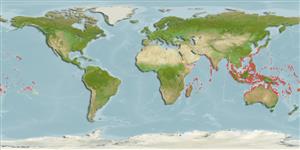Common names from other countries
Environment: milieu / climate zone / depth range / distribution range
экология
ассоциированный с рифами; пределы глубины 0 - 6 m (Ref. 96667). Tropical; 36°N - 33°S, 29°E - 134°W
Indo-Pacific: north from Japan, China, Taiwan to southeast Asia, west to Australia, Christmas Island, Cocos (Keeling) Islands to India, Oman and east Africa.
Length at first maturity / Size / Вес / Возраст
Maturity: Lm ? range ? - ? cm Max length : 8.0 cm CW самец/пол неопределен; (Ref. 343)
Carapace is oval in shape which is covered with tubercles. The frontal margin has six or more spines. Pair of pincers are unequal in size and are covered with very tiny granules (Ref. 128968).
Adults are found in rock cracks in shallow waters. They display aggressive and nocturnal behaviour (Ref. 128968). Collected for food. Occasionally mildly poisonous in some parts of its range. Mildly poisonous (Ref. 79155). Inhabits rocky shore or reefs. Benthic. Subtropical and tropical climates (Ref. 343). Intertidal (Ref. 106854). Also occurs on algal mat (Ref. 106227). Found within crevices in rocks or coral reefs (Ref. 79155). Observed on mangrove trees (Ref. 74547). Has large master claws with molariform teeth used to crush shells of snails and hermit crabs (Ref. 107019). Observed to open large Turbo sp. Shells in order to extract the terrestrial hermit crab Coenobita perlatus (Ref. 76500).
Life cycle and mating behavior
половая зрелость | размножение | нерест | икра | Fecundity | личинки
Members of the order Decapoda are mostly gonochoric. Mating behavior: Precopulatory courtship ritual is common (through olfactory and tactile cues); usually indirect sperm transfer.
Основная ссылка
ссылки | координатор | соавторы
Ng, P.K.L. 1998. (Ref. 343)
Статус Красного Списка МСОП (Ref. 130435)
Статус СИТЕС (Ref. 108899)
Not Evaluated
Not Evaluated
Угроза для людей
Poisonous to eat (Ref. 128968)
Использование человеком
рыболовство: коммерческий
| FishSource | Sea Around Us
инструменты
дополнительная информация
Возраст/РазмерыростЗависимость между длиной и массой телаЗависимость между длинамиморфологияличинкичисленность
ресурсы в Интернет
Estimates based on models
Preferred temperature
(Ref.
115969): 24.8 - 29.3, mean 28.4 (based on 3372 cells).
устойчивость к внешним воздействиям
высокий, минимальное время удвоения популяции до 15 месяцев (K=0.68).
Уязвимость
Low vulnerability (10 of 100).
Категория цены
Unknown.
